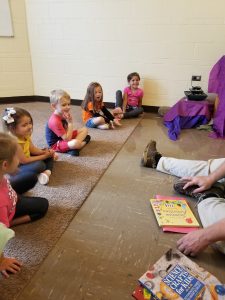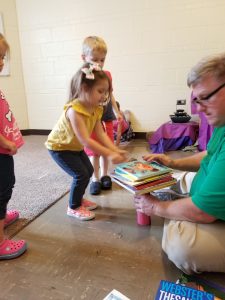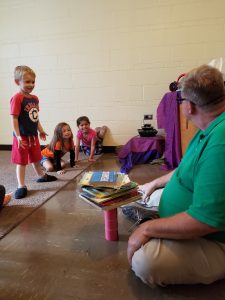Welcome to another month of science! Mr.John has kept us busy with new science experiments.
During each science activity, we always come up with our own hypothesis. A hypothesis is an educated guess. A great part about Mr.John’s science class is that it never matters if our hypothesis is wrong or right! Mr. John always tells us that it is okay to be wrong because sometimes even scientists are wrong! That is how they learn what works and what doesn’t work.
Don’t forget to check your students science paper in their folder ever Thursday to see what their hypothesis was for that weeks experiment!
Distribution of Weight
Materials needed to complete this activity at home:
- Books
- A piece of paper
- A couple of rubber bands
Question of the week: What will happen when we try to balance a text book or multiple picture books on a piece of paper? What about when the piece of paper is turned into a cylinder?
Well, the flat paper got squished by the books! Then Mr. John turned it into a cylinder using rubber bands. What happened next?

The cylinder of paper supported all the picture books! Amazing!


But why was the cylinder of paper able to hold the book, but the single piece of paper did not? SCIENCE!
The average weight of a piece of paper is .7 grams. It makes sense that it wouldn’t be able to balance a book! It just collapses under the weight of a book. This is because the paper is unable to keep it’s shape. It wants to return to a flat position. But, when Mr.John uses rubber bands to keep the paper in a cylinder shape, it all changes.
The secret to the paper’s new found strength is the geometrical shape known as a cylinder! Cylinders are one of the most structurally sound and strongest geometrical shapes. They are able to be strong because they disperse stress throughout their entire shape. If the rolled-up piece of paper were a perfect cylinder, the strength of it would be even stronger!
Teflon Tape Secret Message
Question: What will happen if we write a secret message on a strip of Teflon tape?
Materials Needed:
- Teflon tape
- Permanent marker
This week Mr. John introduced us to polymers! On the Teflon tape Mr. John wrote GO BUCKEYES! Then he stretched the tape out so much, we couldn’t read his message anymore!
Then he pulled on it again and SCIENCE made the letters legible again! But how?
Teflon tape is a type of polymer called polytetrafluoroethylene (PTFE). That’s a really long word for a kind of polymer that has long chains of molecules lined up side-by-side and on top of each other. Polymers like to be near each other. After Mr. John stretched the tape, the polymers that make up the tape were all puled apart. When Mr. John pulls in the opposite way on the tape firmly, the polymers become reconnected together which allows the message to be legible again.
Friction
Mr.John was absent this week, so I (Miss Ame) stepped in with a shortened version of science for our classes.
Materials:
- Spider print out
- Sewing thread
- cardboard
- Match
The spider was glue to a small piece of cardboard. On the other side of the cardboard was a match attached to it with glue. In between the match and the cardboard was a piece of thread.
Using our imagination we pretended that the thread was the spider’s web. While I was holding both ends of the web tightly, the spider did not move. He was suspending sitting still in his web.
I then asked the student’s what they thought would happen if I let go of the string that I was holding our spider. Would he fall? Would he stay hanging on his web? So each child shared their hypothesis, all starting their sentence with “My hypothesis…”
On the count of three I let go of the spider…..and he fell quickly to the end of his web! But why?
Because of friction!
When the thread is held taut, it touches the match. This causes friction between the match and the thread, which is strong enough to stop the spider from moving down the thread. But, when you let it go slack it no longer touches the match. This means less friction, so the spider slides easily down.
